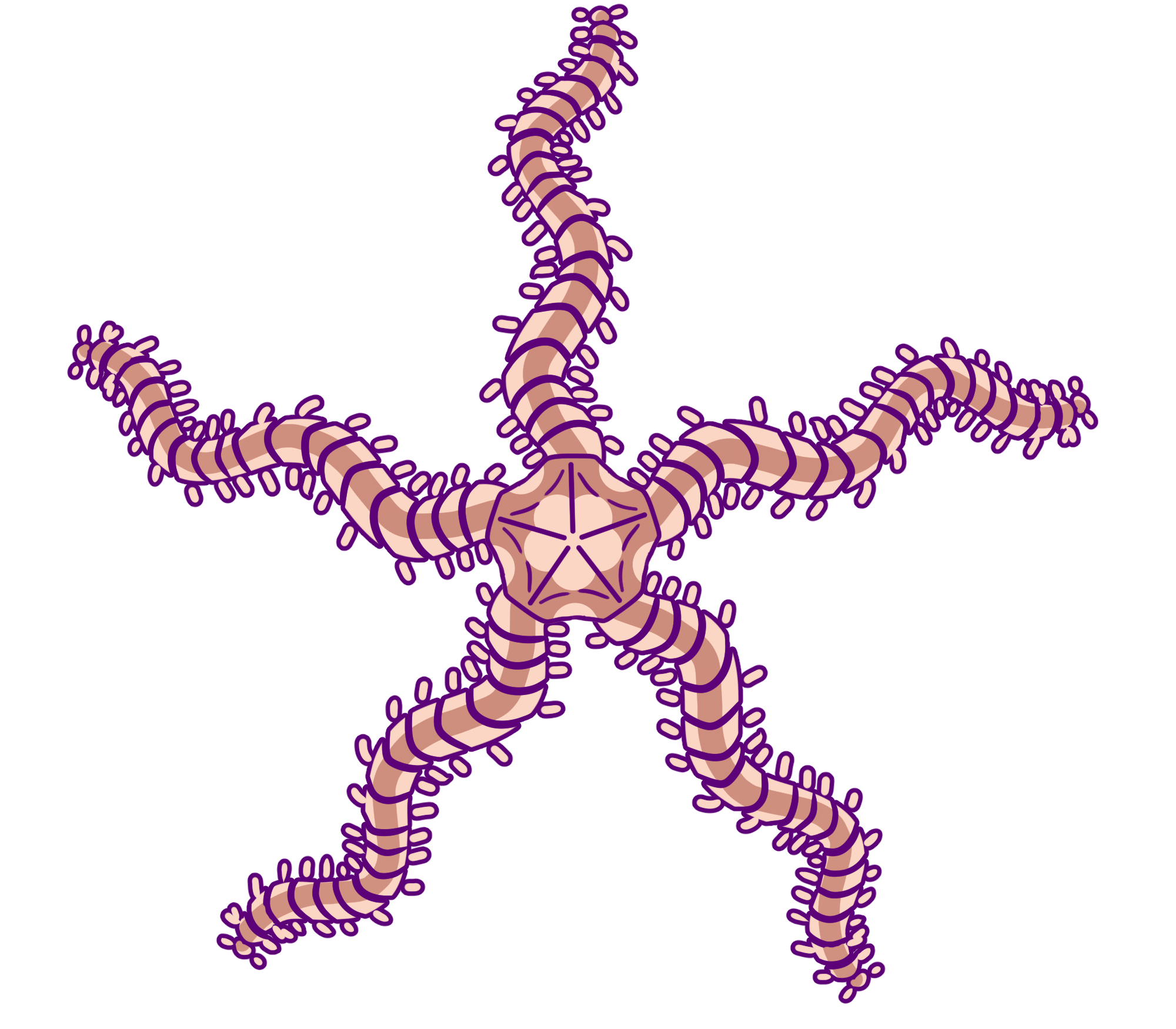While exploring the intertidal zone of La Jolla Cove, you can find these skinny dancers camouflaging their bodies beneath the algae. If you pick them up, you might be scared of them escaping your hold like a snake. They chop off their long “hands” from their bodies and slither away into the algae. Upon taking a closer look, you realize that they are not snakes but brittle stars!

Under the phylum Echinodermata, brittle stars (Ophiuroidea) are the close relatives of starfish. With a similar shape to starfish, they have five long, slender arms that radiate from a central disk, which render them the fastest among their echinoderm relatives. A study done by Thomas Jefferson University reveals that each flexible arm consists of over 100 segments. Each segment has a central vertebrae-like skeleton, called an ossicle, which is encircled by ring-like skin plates. The distinct shapes of the ossicles endow the arms with a pliable structure, allowing the brittle stars to achieve a high level of mobility. With this delicate moving mechanism, they gracefully stretch their arms to caress the seafloor sediment and spin like a ballerina to dance in the ocean.
Being bottom-dwellers, brittle stars developed effective feeding strategies to capture suspended particles. They inhabit a wide range of marine ecosystems, from the intertidal zone down to the ocean floor at over 8000 meters deep. However, they largely dominate soft-bottom marine ecosystems consisting of mud and sand sediment. They feed by burrowing their bodies under the sediment and extending several arms to capture detritus and plankton suspended in water. Resembling a rope dancer, they stick to the ocean floor and willingly spin their arms. Scientists from the University of Auckland investigated the animals’ feeding methods and discovered that each segment of their arms bears a vertical row of spines responsible for their feeding mechanisms. These spines secrete mucus to capture food and contain sensory cells that work as flood sensors. When the sensory cells detect reduced water flow caused by accumulated mucus, the tube-like feet on the underside of the arms will lick around the spines to gather and pass the mucus along the arms to the brittle star’s mouth.
Furthermore, brittle stars’ feeding behaviors significantly modify the chemical and physical characteristics of the sediment they occupy. On land, earthworms dig through the soil and move sediments from one layer to another. Similar to the role of earthworms, brittle stars mix different layers of sediments and irrigate the sediments with oxygen-rich water. This process promotes the underwater carbon cycle, a natural way to trap carbon from the atmosphere into the ocean. Additionally, their feeding process may even reduce the harm caused by pollutants. The 2010 Deepwater Horizon oil spill generated numerous oil pollutants that drifted down to the ocean floor, damaging the coral reef ecosystems in the Gulf of Mexico. However, scientists from the Smithsonian Institution found that a few sections of coral that had been wrapped by brittle stars were able to survive among other damaged corals. They proposed that the brittle stars covered the coral polyps with their feeding arms and captured the suspended oil pollutants, which prevents the pollutants from contacting the coral. Through filtering out suspended sediments, brittle stars have the potential to clean the ocean environment.
Though brittle stars are less concerned with extinction, they face escalating challenges due to climate change. Their feeding strategy exposes them to potential arm damage as stretching their arms out into the water makes them susceptible to predation. Upon sublethal threat, brittle stars will discard their arms to protect the body from damage, a process called “ophiuroid autotomy.” After they escape from a threat, they need to face the high energy cost of arm regeneration. Temperature is a fundamental abiotic factor in determining the regeneration rate since it significantly impacts the metabolic rate of brittle stars. As a result, abnormal changes in temperature negatively influence their efficiency in regenerating damaged arms. According to studies done by the University of Plymouth, temperature oscillation, ocean acidification, and hypoxia have also reduced brittle stars’ ability to regulate the sedimentary nutrient flux. These unstable climate conditions have the potential to greatly affect brittle stars’ ability to regenerate their arms and regulate ocean chemical circulations.
A brittle star is tiny and fragile, but their population has a significant impact on bottom ocean ecosystems by promoting carbon cycles and cleaning up suspended particles. However, anthropogenic activities damage their habitats and alter their living environmental conditions. Restoration of their habitats is necessary.
The first step can be initiated in one’s first acquaintance with these species in La Jolla Cove. When you spot these graceful dancers in the algal zone, please leave them on their stage and enjoy their performance. If you lift them up, they might feel pressured to cut off all their arms and would not be able to dance anymore. To protect them, we should start with respecting the animals and their habitats.

